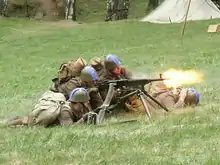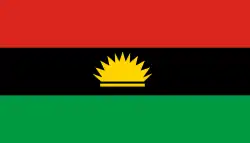ZB-53
The ZB-53 was a Czechoslovak machine gun. A versatile weapon, it was used both as a squad support weapon, as a mounted machine gun for tanks and other armoured vehicles, and on fixed positions inside Czechoslovak border fortifications. Adopted before the World War II by the armies of Czechoslovakia (as TK vz. 37) and Romania, it was also license-built in the United Kingdom as the Besa machine gun. Following the German invasion of Czechoslovakia, large quantities of the weapon were captured by the Wehrmacht and used during the war under the designation of MG 37(t).
| ZB-53, Vz.37 | |
|---|---|
 | |
| Type | Medium machine gun |
| Place of origin | Czechoslovakia |
| Service history | |
| In service | 1937–1960s (Czechoslovakia) |
| Used by | See Users |
| Wars | |
| Production history | |
| Designer | Václav Holek |
| Designed | 1935 |
| Manufacturer | Zbrojovka Brno |
| Produced | 1936–early 1950s |
| Specifications | |
| Mass | 21 kg (46 lb) empty |
| Length | 1.105 m (43.5 in) |
| Barrel length | 0.736 m (29.0 in) |
| Cartridge | 7.92×57mm Mauser |
| Calibre | 7.9 mm |
| Action | Gas-operated |
| Rate of fire | 500–800 round/min |
| Feed system | 225-round metal link belt |
History
The ZB-53 was designed by Václav Holek and Miroslav Rolčík of the Zbrojovka Brno works as a replacement for the Schwarzlose machine gun of World War I origin. Based on the earlier vz. 35 machine gun, the prototype was tested in 1936 and the following year the new machine gun was adopted by the Czechoslovak Army with the designation TK vz. 37 ("Heavy Machine Gun Mark 1937").[2] It was introduced as the standard machine gun of Czechoslovak LT-35 and LT-38 tanks. Czechoslovakia exported the gun to Romania, Yugoslavia, Argentina, Afghanistan, Iran and China (large numbers used during the Second Sino-Japanese War[3]), while UK bought a license and started to produce its own version, known as the Besa machine gun (over 60,000 pieces made). During the German occupation of the factory, large numbers were produced for the Waffen-SS until 1942.[4]
Czechoslovak Zbrojovka Brno and then Zbrojovka Vsetín produced the gun in large quantities until the 1950s.
The weapon was a gas-operated, belt-fed, air-cooled machine gun that served both the infantry support and vehicle weapons roles. The machine gun was delivered in three variants: infantry machine gun (on heavy tripod), heavy bunker machine gun (with heavier barrel, marked "O") and for armoured vehicles (marked "ÚV"). It was designed to withstand five minutes of constant fire, after which time the barrel had to be changed due to wear. Although modern, the weapon was prone to jamming due to a complicated rate of fire selection mechanism.
Users

 Afghanistan[5]
Afghanistan[5] Argentina
Argentina.svg.png.webp) Bangladesh: Used by Mukti Bahini forces during the Bangladesh Liberation War[6]
Bangladesh: Used by Mukti Bahini forces during the Bangladesh Liberation War[6] Biafra: At least 20 were sold to Biafra in 1967.[7]
Biafra: At least 20 were sold to Biafra in 1967.[7] Chile
Chile China[8]
China[8] Czechoslovakia[8]
Czechoslovakia[8] Cuba[9][10]
Cuba[9][10].svg.png.webp) Nazi Germany
Nazi Germany Israel[11]
Israel[11].svg.png.webp) Iran[8]
Iran[8] Namibia used by PLAN [12]
Namibia used by PLAN [12] United Kingdom: Besa machine gun[8]
United Kingdom: Besa machine gun[8].svg.png.webp) Venezuela
Venezuela Romania:[8] 5,500 purchased by mid-1943[13]
Romania:[8] 5,500 purchased by mid-1943[13].svg.png.webp) Spain[14]
Spain[14].svg.png.webp) Socialist Federal Republic of Yugoslavia[8]
Socialist Federal Republic of Yugoslavia[8]
References
- "Arms for freedom". 29 December 2017. Retrieved 2019-08-31.
- "TK" stands for "těžký kulomet", heavy machine gun, while "vz" means "vzor", Model
- Jowett, Philip (20 Nov 2013). China's Wars: Rousing the Dragon 1894-1949. General Military. Osprey Publishing. p. 306. ISBN 9781782004073.
- "MG 37 (t) & VZ 37 & ZB 53". iwm.org.uk. Imperial War Museum.
- Bhatia, Michael Vinai; Sedra, Mark (May 2008). Small Arms Survey (ed.). Afghanistan, Arms and Conflict: Armed Groups, Disarmament and Security in a Post-War Society. Routledge. p. 65. ISBN 978-0-415-45308-0.
- Bangladesh Liberation War 1971: Freedom's Arms, retrieved 2019-09-19
- Jowett, Philip (2016). Modern African Wars (5): The Nigerian-Biafran War 1967-70. Oxford: Osprey Publishing Press. p. 22. ISBN 978-1472816092.
- Popenker, Maxim. "ZB 53 / Vz.37". modernfirearms.net.
- Rob Krott (April 2000). "The Bay of Pigs Museum: Playa Giron, Cuba". Small Arms Review. Vol. 3 no. 7. Chipotle Publishing. Retrieved 1 February 2017.
- Smith, Joseph E. (1969). Small Arms of the World (11 ed.). Harrisburg, Pennsylvania: The Stackpole Company. p. 300.
- Laffin, John (29 Jul 1982). The Israeli Army in the Middle East Wars 1948–73. Men-at-Arms 127. Osprey Publishing. p. 8. ISBN 9780850454505.
- "Their Blood Waters our Freedom". Youtube.com. 25 January 2020. Retrieved 19 May 2020.
- Mark Axworthy, London: Arms and Armour, 1995, Third Axis, Fourth Ally: Romanian Armed Forces in the European War, 1941–1945, p. 29
- Alejos Cutuli, Félix A. (May 2012). "La Coruña Military Museum". Small Arms Review SAW.
- Andrzej Ciepliński; Ryszard Woźniak (1994). "Encyklopedia współczesnej broni palnej: Od połowy XIX wieku". Encyklopedia współczesnej broni palnej (in Polish). Warsaw: WiS. ISBN 83-86028-01-7.
External links
| Wikimedia Commons has media related to ZB vz. 37. |
